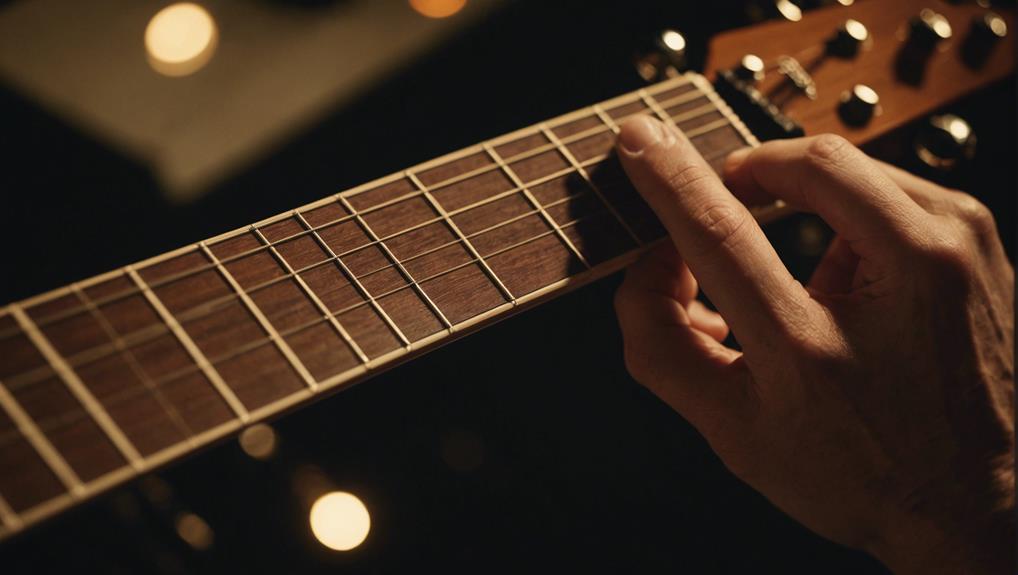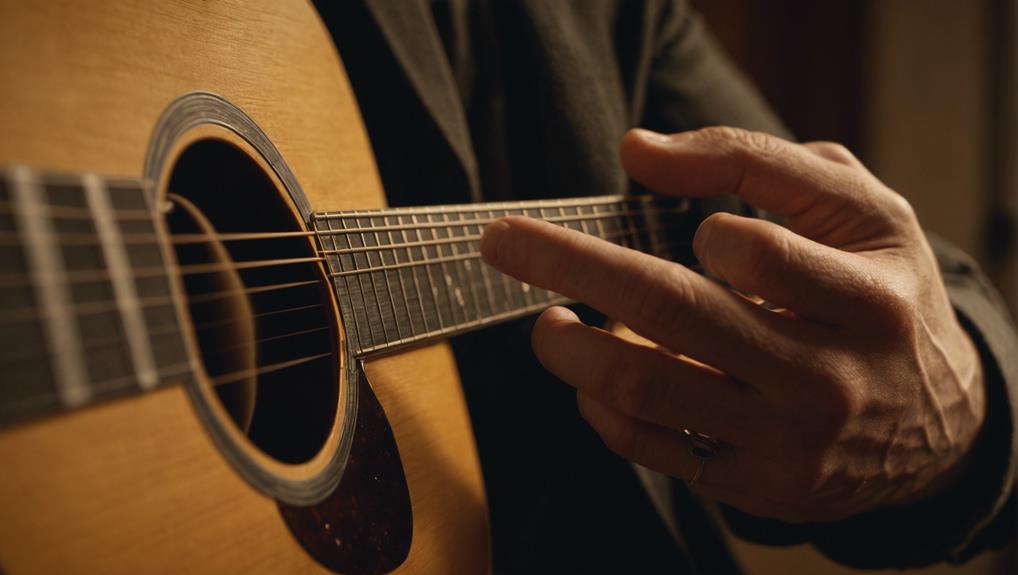When you first start learning to read guitar tabs, you’ll notice the six horizontal lines represent the strings of your guitar, with the bottom line as the low E and the top line as the high E. Each number on these lines tells you which fret to press, guiding your finger placement.
You’ll read the tabs from left to right, much like sentences, to play the notes in sequence. Pay close attention to chord structures, shown with vertically stacked numbers, and special symbols that add dynamics to your playing. But how do you interpret these symbols to enhance your guitar technique?
TL-DR
- Guitar tabs have six horizontal lines representing the guitar strings, from low E (bottom) to high E (top).
- Numbers on the lines indicate which fret to press on the corresponding string.
- Tabs are read from left to right, similar to reading sentences.
- Vertically stacked numbers represent chords that should be played simultaneously.
- Special symbols like ‘h’, ‘p’, and arrows denote hammer-ons, pull-offs, and bends, respectively.
Understanding Guitar Tabs
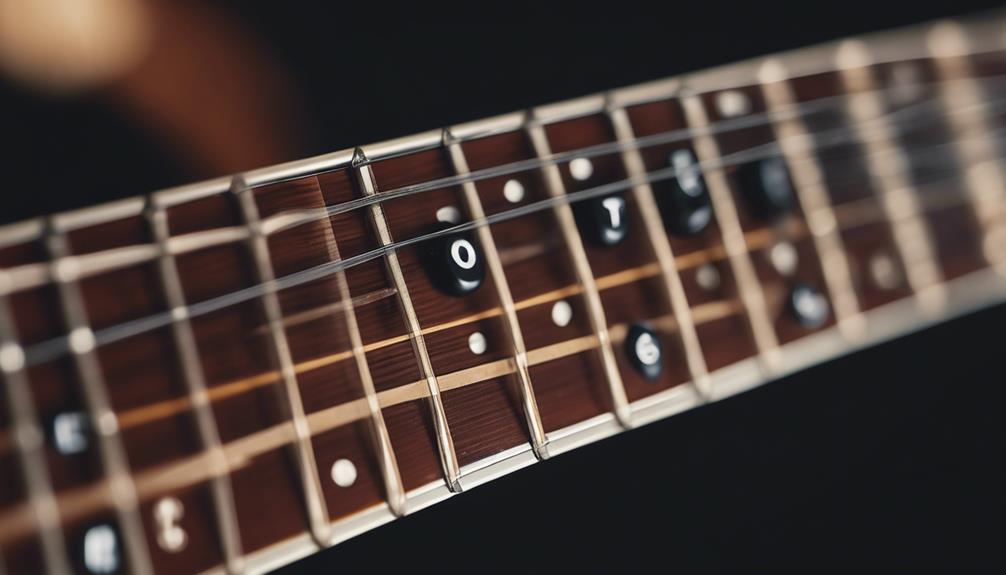
When learning to read guitar tabs, you’ll see six horizontal lines that represent the six strings of the guitar. Each line corresponds to a guitar string, with the bottom line as the thickest string (low E) and the top line as the thinnest string (high E). Numbers on these lines indicate which fret you should press down. For example, a ‘3’ on the bottom line means you’ll press the third fret on the low E string.
Tabs are a fundamental notation system that allows you to play single notes, chords, arpeggios, and riffs. To read a tab, start from the left and move to the right, similar to how you read sentences. This helps you learn songs in the correct order. Plucking the strings as indicated by the numbers ensures you’re playing the correct notes.
Your hand positioning is essential. Place your fingers on the frets as shown and use your other hand to pluck the strings. Mastering this will enable you to play accurately.
Unlike chord charts that show finger positions, tabs focus on which frets and strings to play, making it easier to follow along and learn new music.
Deciphering the Tab Staff
To decipher the tab staff, focus on the six horizontal lines, each representing a different string of the guitar. The top line represents the thinnest string (high E), while the bottom line represents the thickest string (low E).
When you learn how to read tabs, you’ll see numbers on these lines. Each number is a fret number, indicating which fret to press on that string to produce a specific note.
Reading tabs means interpreting the sequence of numbers from left to right, playing each note in chronological order. For instance, if you see a ‘3’ on the bottom line, it means you should press the third fret on the low E string to play that note.
As you progress, you’ll encounter vertically stacked numbers. This tab notation means you must press multiple frets simultaneously to represent a chord.
Understanding tab staff layout is essential for accurately playing guitar tabs and helps you learn your favorite songs more easily. By getting comfortable with this system, you’ll quickly identify the notes to play and smoothly shift from one note to the next, making your guitar learning journey much smoother.
Reading Fret Numbers
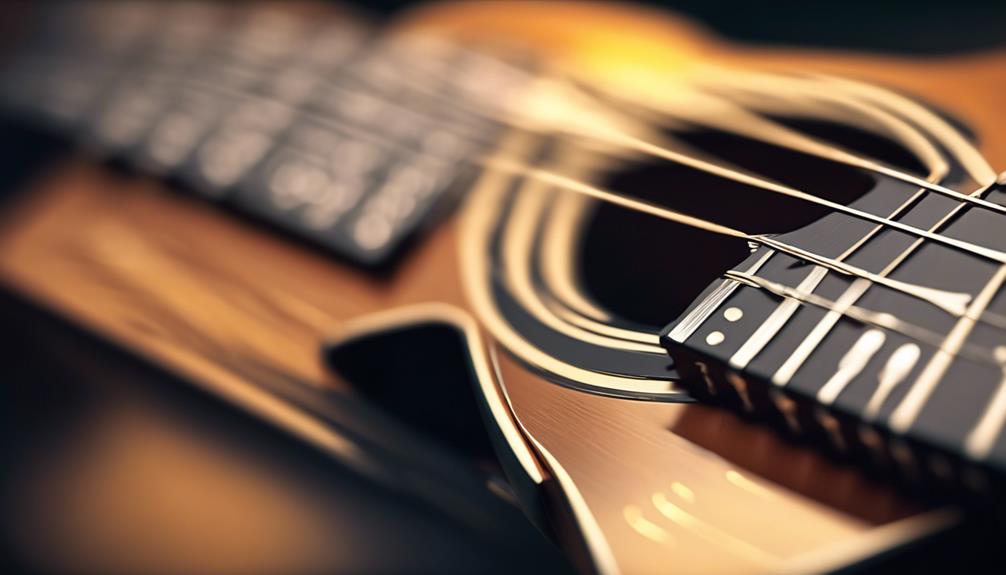
When reading fret numbers, you need to understand where to place your fingers on the fretboard. Each number on the tab tells you which fret to press on a specific string, ensuring you play the correct notes and chords.
Understanding String Placement
Understanding string placement in guitar tabs starts with recognizing that each line represents a specific string on your guitar. When you read guitar tabs, you’ll see six lines stacked horizontally. The top line corresponds to the thinnest string, known as the high E string, while the bottom line corresponds to the thickest string, called the low E string.
Each line tells you which string to play, and the numbers on these lines, called fret numbers, show you where to place your fingers on the guitar neck. For example, if you see a ‘3’ on the bottom line, place your fretting hand on the third fret of the low E string. Tabs guide you in playing music by indicating both the string and specific fret, making it easier to learn songs without needing to read traditional sheet music.
A tab consists of these lines and numbers, providing a visual map for your fingers.
Mastering string placement and fret numbers is essential for accurately playing melodies, chords, and riffs. By learning how to read tabs, you’re setting yourself up for success in playing your favorite songs and developing your guitar skills.
Interpreting Numbered Frets
Reading fret numbers in guitar tabs is essential for knowing exactly where to place your fingers on the fretboard. Each number corresponds to a specific fret and string, guiding you to produce the correct note.
For instance, a ‘3’ on the G string means you should press down on the third fret of the G string. Lower numbers like 0 indicate open strings, which you play without pressing any frets.
Understanding this relationship between fret numbers and finger positions is important. When you read TAB, you’ll see numbers on lines representing the strings of the guitar. Use your left hand to position your fingers accordingly and your right hand to pluck or strum.
Sometimes you’ll encounter special instructions like a BEND, which means you should push the string up or down to change the note’s pitch.
Mastering fret numbers helps you play melodies, chords, and solos accurately.
Whether you’re playing a simple note or a complex solo, knowing where to place your fingers on each fret is essential. With practice, interpreting these fret numbers will become second nature, and you’ll be able to bring your music to life effortlessly.
Recognizing Chord Structures
Guitar tabs reveal chord structures with vertically stacked numbers, each showing which fret to press on specific strings. These stacked numbers represent the fret to be pressed on multiple strings simultaneously, forming the chord. By recognizing chord structures, you can play chords accurately and efficiently. Tabs simplify complex chord formations by visually displaying finger positions on the fretboard, making it easier to understand.
When you see these vertically stacked numbers, you’re looking at a complete chord. Each number corresponds to a string, and the position in the stack indicates which fret to press. For instance, a stack might show: 3 on the low E string, 2 on the A string, and 0 on the D string, forming a simple G chord. This visual representation is essential for playing rhythm guitar and accompanying songs.
Understanding how to read these chord structures in guitar tabs is vital. It helps you shift between chords smoothly and play rhythm sections more effectively. By familiarizing yourself with these visual cues, you simplify the process of learning and executing complex chord formations, making you a more proficient guitarist.
Interpreting Special Symbols
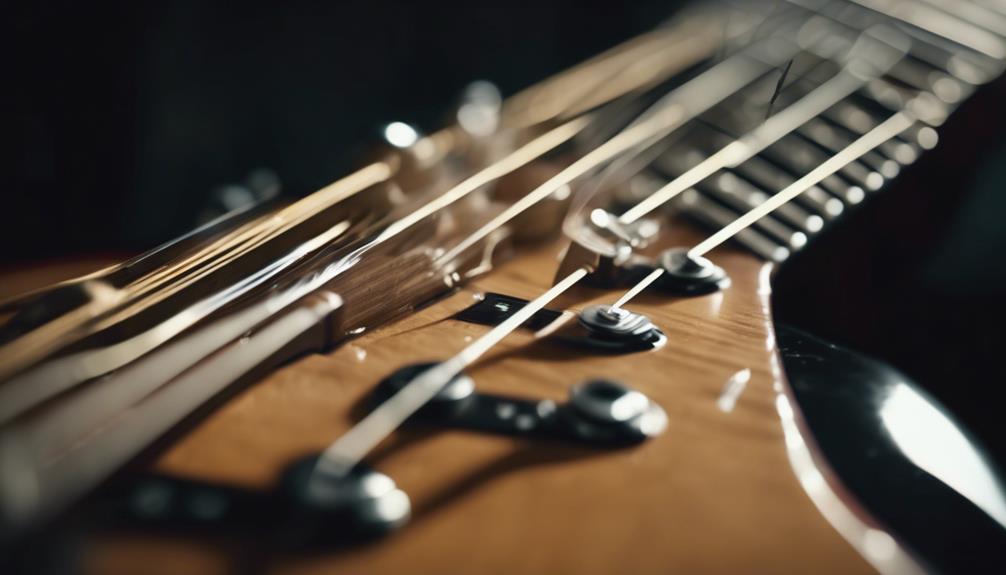
Mastering special symbols in guitar tabs is essential for accurately replicating various playing techniques. When you see ‘h’ in guitar tabs, it denotes a hammer-on, which involves striking a note and then pressing another fret without picking again.
Conversely, ‘p’ indicates a pull-off, where you pluck a note and then release it to a lower note on the same string.
Bending, marked with a ‘b’, requires you to push or pull the string to raise its pitch. This technique often appears with additional notation like ‘7b9’, meaning bend the string at the 7th fret to match the pitch of the 9th fret.
The sliding technique, shown by ‘/’ (slide up) or ‘\’ (slide down), connects two notes to indicate a smooth shift from one to another. For instance, ‘5/7’ means you should slide your finger from the 5th fret to the 7th.
Vibrato, represented by a wavy line, adds expressiveness to sustained notes by rapidly oscillating the pitch. Your mastery of these special symbols like hammer-ons, pull-offs, and bends will greatly enhance your ability to play songs accurately and with the intended feel.
Techniques and Dynamics
When reading guitar tabs, you’ll encounter symbols for techniques like hammer-ons, pull-offs, bending, and vibrato, each adding unique dynamics to your playing.
Mastering these techniques will bring more expression and emotion to your music.
Pay attention to the picking direction indicated by downstrokes and upstrokes, as it greatly affects the song’s feel.
Hammer-ons and Pull-offs
Learning how to execute hammer-ons and pull-offs will greatly enhance your guitar playing by adding smooth shifts and expressive dynamics.
Hammer-ons involve tapping a fretted note with your left hand, creating a seamless progression without having to pick the string again. This technique is vital for lead guitar, as it produces a legato effect that makes your melodies flow effortlessly.
On the other hand, pull-offs require you to lift your finger off a fretted note, allowing the previous note to ring out without re-picking the string.
Mastering hammer-ons and pull-offs can greatly elevate your playing style, enabling you to tackle faster and more intricate pieces. These techniques not only add fluidity to your playing but also bring out the dynamics in your music, making it more expressive and engaging.
Practicing these moves will help you develop better control over your left hand, essential for executing complex lead guitar parts.
In reading guitar tabs, hammer-ons are usually indicated by an ‘h’ between two notes, while pull-offs are marked with a ‘p.’ Understanding and applying these techniques will open up new avenues for creating rich, connected melodies on your guitar.
Bending and Vibrato
You can dramatically elevate your guitar playing by incorporating bending and vibrato techniques to add dynamics and expressiveness.
When you bend guitar strings, you’re altering the pitch to create a smoother shift between notes. A Full Bend raises the pitch by two frets, while a half Bend lifts it by one fret. These bending techniques are denoted in tabs with arrows indicating their direction and extent. They add a distinct tonal effect, making your guitar playing more emotional and dynamic.
Vibrato, marked by a squiggly line over a note in tabs, involves rapidly varying the pitch to add warmth and richness to your sound. This subtle modulation makes your playing more expressive and engaging. Mastering vibrato helps you infuse each note with personal style, enhancing the overall emotion conveyed by your music.
Combining bending and vibrato techniques allows you to explore new dimensions of expressiveness in guitar playing. Whether you’re executing a smooth Full Bend or a delicate vibrato, these techniques contribute significantly to the dynamics and emotion of your performance.
Dynamics and Articulation
Mastering dynamics and articulation in guitar playing allows you to convey a wide range of emotions and expressions through your music. Dynamics involve changes in volume and intensity, making your playing more engaging.
Articulation techniques like hammer-ons and pull-offs add unique character to each note, while vibrato gives notes a rich, expressive quality. Smooth shifts between notes, adding fluidity to your playing.
Palm muting is another essential technique, where you rest your palm on the strings near the bridge to produce a muted, percussive sound. This method is excellent for adding texture and varying the dynamics within your music.
Downstrokes and upstrokes, the directions in which you pick the strings, also influence the dynamics and overall feel of your playing. Downstrokes often create a more forceful sound, while upstrokes can be lighter and more subtle.
Next up, learn basic guitar chords in this guide.
